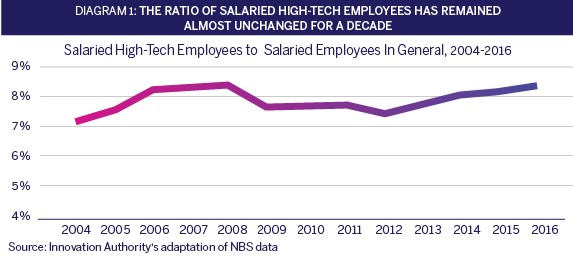One of the central questions surrounding the discussion about the shortage of skilled high-tech employees is why it is that the high salary, that reflects the high demand for these workers, is not enough to attract more workers to choose this career path. The significance of the disparity between the average wage in the high-tech industry – NIS 21,000 per month – and the average wage in the economy at large – approximately NIS 9,8001 National Bureau of Statistics, Annual Statistics Journal 2017, Panel 12.33 (2016 data). This large difference becomes even more significant taking into account the complex high cost of living in Israel. Nonetheless, the figures indicate a more than decade-long stability in the ratio of salaried employees working in high-tech (see Diagram 1)2, Calculated after adaptation of NBS data by the Strategy and Economic Division of the Innovation Authority. The adaptation included revaluation and historic adjustment of all salaried employees by retroactively adding the number of salaried employees in the I.D.F. (regular and permanent service) including before 2012 (the year in which the NBS began publishing the total figure).compared to a thriving corporate demand for labor expressed by a constant increase in salaries.

There are a number of explanations for this phenomenon. Firstly, high-tech career paths traditionally pass through a relatively limited number of entrance gates, the central ones being academic studies of engineering or computer science or service in the I.D.F. technological units. The entrance thresholds for these tracks are relatively high and filter out many young people interested in joining them including those young people who are endowed with the basic talents necessary for succeeding in high-tech professions. In this context, it should be mentioned that the national program for increasing skilled personnel to the high-tech industry set a target increase of 40 percent in the number of higher education students in high-tech professions. The main thrust of effort in this direction will be undertaken by the universities. In order to achieve the goal, the Planning and Budgeting Committee in the Council for Higher Education is operating in several avenues: expanding the academic staff in high-tech professions, developing the necessary physical infrastructure, reducing the drop-out rate from high-tech professions, increasing the rate of special populations in these fields, especially women, the computerization of courses and others.
Secondly, there is a significant group of young people capable of meeting the academic entrance criteria for engineering or computer science professions but who choose a different route. This is explained by the fact that the striking advantages of the high-tech industry are not at the top of their list of priorities when making a career choice. The choice of study field, which to a large degree shapes their future career path, is generally made in the early 20’s and is based on perceptions and priorities reflected at that point in time. According to an OECD study, young people choose a field of study according to (in descending order) interest, self-fulfillment, future salary and convenience.3 OECD (2008). Encouraging Students Interest in Science and Technology Studies This order of priorities may change during their professional lives, as may their perceptions regarding interest and self-fulfillment at work.
The modern labor market is characterized by frequent changes in demand for different professions. On the other hand, the increase in life expectancy results in careers that may last many long years. The option to change track during one’s career therefore assumes great importance. Today, many young people who previously chose a particular study field are now changing their career preferences after a period of familiarization with the labor market, but the perception according to which a professional change involves a return to academic studies reduces their motivation to embark upon such a move.
The high demand in the high-tech industry for recent graduates of I.D.F technology units illustrates however that academic studies, with all their obvious advantages, are not the only way to become a part of the industry. Indeed, some of the high-tech companies in Israel – especially dynamic software companies that recruit a large number of programmers – adopt selection processes based on talents and abilities, without reference to the candidate’s formal education. This phenomenon is also linked to the increasing demand for programmers throughout the entire market. The existing shortage drives the employers to recruit talented workers via alternative means, thereby creating opportunities for wider circles of the population to join the high-tech industry.
- [1] National Bureau of Statistics, Annual Statistics Journal 2017, Panel 12.33 (2016 data) ↩︎
- [2] Calculated after adaptation of NBS data by the Strategy and Economic Division of the Innovation Authority. The adaptation included revaluation and historic adjustment of all salaried employees by retroactively adding the number of salaried employees in the I.D.F. (regular and permanent service) including before 2012 (the year in which the NBS began publishing the total figure). ↩︎
- [3] OECD (2008). Encouraging Students Interest in Science and Technology Studies ↩︎
